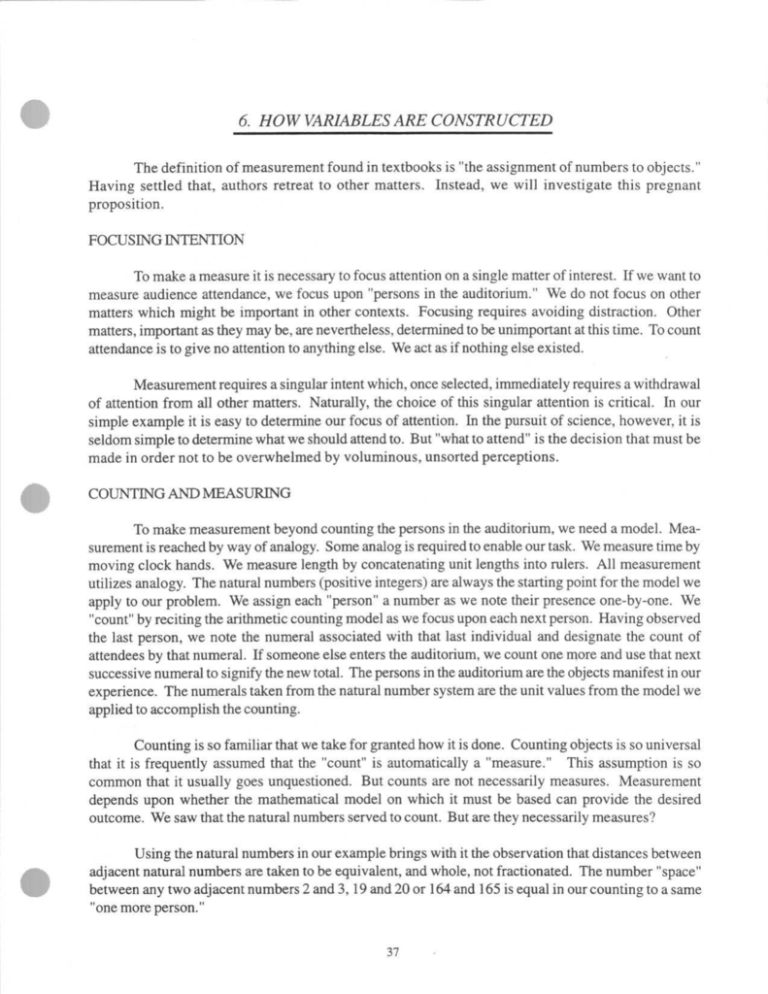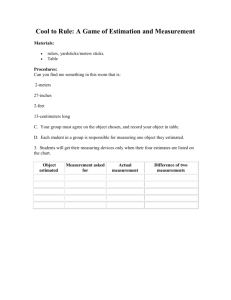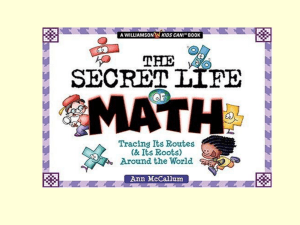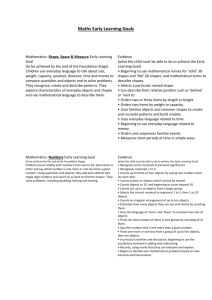
6. HOW VARIABLES ARE CONSTRUCTED
The definition of measurement found in textbooks is "the assignment of numbers to objects ."
Having settled that, authors retreat to other matters . Instead, we will investigate this pregnant
proposition.
FOCUSING INTENTION
To make a measure it is necessary to focus attention on a single matter of interest. If we want to
measure audience attendance, we focus upon "persons in the auditorium ." We do not focus on other
matters which might be important in other contexts . Focusing requires avoiding distraction . Other
matters, important as they may be, are nevertheless, determined to be unimportant at this time. To count
attendance is to give no attention to anything else . We act as if nothing else existed.
Measurement requires a singular intent which, once selected, immediately requires a withdrawal
of attention from all other matters. Naturally, the choice of this singular attention is critical . In our
simple example it is easy to determine our focus of attention. In the pursuit of science, however, it is
seldom simple to determine what we should attend to . But "what to attend" is the decision that must be
made in order not to be overwhelmed by voluminous, unsorted perceptions .
COUNTING AND MEASURING
To make measurement beyond counting the persons in the auditorium, we need a model . Measurement is reached by way of analogy. Some analog is required to enable our task. We measure time by
moving clock hands. We measure length by concatenating unit lengths into rulers . All measurement
utilizes analogy. The natural numbers (positive integers) are always the starting point for the model we
apply to our problem. We assign each "person" a number as we note their presence one-by-one. We
"count" by reciting the arithmetic counting model as we focus upon each next person . Having observed
the last person, we note the numeral associated with that last individual and designate the count of
attendees by that numeral . If someone else enters the auditorium, we count one more and use that next
successive numeral to signify the new total. The persons in the auditorium are the objects manifest in our
experience . The numerals taken from the natural number system are the unit values from the model we
applied to accomplish the counting .
Counting is so familiar that we take for granted how it is done . Counting objects is so universal
that it is frequently assumed that the "count" is automatically a "measure." This assumption is so
common that it usually goes unquestioned . But counts are not necessarily measures . Measurement
depends upon whether the mathematical model on which it must be based can provide the desired
outcome. We saw that the natural numbers served to count. But are they necessarily measures?
Using the natural numbers in our example brings with it the observation that distances between
adjacent natural numbers are taken to be equivalent, and whole, not fractionated . The number "space"
between any two adjacent numbers 2 and 3, 19 and 20 or 164 and 165 is equal in our counting to a same
one more person ."
37
When measuring length with a ruler, we also use the equal steps of the real numbers as our
model . But fractional parts are permitted. Any unit or fractional part of a unit along the real number line
is equal in magnitude to any other like unit or fractional part anywhere along the line .
The natural numbers used in counting are logically consistent . But does the application of these
numbers to every experience automatically endow the objects ofthat experience with similar numerical
properties? This question often goes unanswered because it is unrecognized . Since numbers are logi
cally coherent, the objects to which they are applied are often assumed to possess similar logical coherent numerical characteristics . But this association can not be assumed. It must be constructed, demonstrated and maintained . Unfortunately, this demonstration is rarely done and objects are usually naively
assumed to possess the same numerical characteristics as those ofthe number system that is used to count
them.
Since measurement is made by analogy, the model chosen for measurement cannot itself substantiate the numerical qualities assigned to the objects. We have to demonstrate that the relationship of the
objects to the model is consistent with our use and understanding of the numerical result and demonstrate
this connection by means of the analogy.
While counting is the model for measurement it is seldom measurement itself. We begin by
assigning numerals to objects. But we must proceed in a manner which is systematic and reproducible
and which allows us to validate continually the correspondence between the objects addressed and their
counts and between the counts obtained and the measures they may imply.
The count of attendees can be represented directly on the number line.
The number line gives us a model which appears to solve our attendance problem. The model of
the number line (our variable of interest) specifies an equal unit distance between the numerals . The
successive count of persons parallels movement along the line by equal counts . An additional person
adds another equal count to the line . The number line made from our counts is associated with the
"length" registered on a "number of persons" variable .
1 . Successful measurement requires focus upon an attribute of intent to the exclusion of all other
(often equally interesting, but not at this moment relevant) attributes. We cannot progress
until we have made such a choice . The choice is both intent to attend and also intent to
disregard.
2. Acoherent measurement analog is necessary to accomplish the measurement task . The one
we used in our example was the natural number model of arithmetic progression . Application of this model to our problem gave us a useful answer. We needed an analog to solve our
measurement problem: establishing a one-to-one correspondence between counting individuals, seated in the auditorium and numerals on a number line. The idea of a number line
gives us a picture of the variable of intent in a way that facilitates understanding, application
and interpretation.
38
3 . Determining the count of people in the auditorium answered our question, "How many are
here?" Was it a measure? Yes, but only when demonstrated by analogy to be associated in a
meaningful way to our number line - the variable . Use of the number line as the model leads
this time to using the count to measure the "amount" of persons expressed in a linear form .
Consequently, the variable of attendance can be visualized as a line with our total attendance
indicated by a position or "amount" on the line . Carrying around such "lines" of amount is
quite unnecessary to say nothing of inconvenient . We revert back to counts to express this
length in a more compact form . But our understanding of the variable form is the line . The
natural number line is the full expression of the measure of persons, not the count. We use the
count as shorthand for the measure.
Our use of the number line and its associated unit characteristics provides, by analogy, a
clear correspondence between the count and measure. This relationship can be seen as:
6
5
COUNT
4
3
2
1
2
3
4
5
6
MEASURE
where a straight line at 45 degrees with slope of "one" associates counts to measures. But
even though the observed counts end up as the same as the measures in this example, the
counts are not in themselves measures even in this case . They became so here through their
analogy with the number line.
4. Validity of this approach can be demonstrated by replication. The individuals counted can
be seen as alternate equal instances of a single individual - the experiential unit of interest .
We make our count and measure by enumeration. The measurement process is unaffected by
where the count begins i.e. from the back, front or side of the auditorium . Precision depends
only on accuracy in counting and not on any other aspect of the process. The count and the
resulting measure are unaffected by the other matters of gender, race, height, weight .
39
We now proceed to more sophisticated problems, keeping in mind the steps encountered in our
simple example . Although our example was simple, the tasks were sophisticated. We count with such
ease and so routinely that we are no longer aware of the steps we take nor of the confusion that can result
between determining how to make counts and how to make measures. The most difficult task to recognize is how to determine measures from counts . This is because counts are what we always begin with
to determine amounts. Counts can be associated with measures only by establishing a useful relationship . We need to generalize this by deliberating upon the measurement process, specifically upon
constructing a variable .
CONSTRUCTING A VARIABLE
A "variable" is a line with direction - an arrow. The direction implies "more" of the variable .
An "amount" is a distance along the line. More is "more" distance along the line . Length is the example
that comes most easily to mind and eye. More inches, feet, yards, is easily visualized as more distance
along the ruler being applied to the object . Interpretation of such a variable is straightforward and easily
demonstrated visually. This keeps the process forthright and observable . There is no mystery, no
algebra. Calculations may be complex but the outcome can be seen. The line conceptualizing the
variable makes the measurement task visible.
The "variable" must establish and maintain a single line of inquiry. That line of inquiry has to be
operationally determined and reproducible at will . To be useful its determination must also be insightful
and rich. Conceptualization as a one unidimensional line is necessary, if our thinking is to progress
usefully. When this is not done, confusion and frustration result . Then there is no simple way to
determine what the variable should be .
Our intent specifies what we will address and not address. Our choice not to address matters is
selective and not unalterable. We can change our mind . What we cannot do is to pursue two things at
once and remain clear about what we are accomplishing.
A measure of "attendance" need not be a measure of speaker "attraction ." It may be an interesting
problem to discover whether attendance is a measure of "agreement" with the speaker. But attendance
itself, does not directly answer that question . We confuse ourselves when we pose unclear questions.
The task is to separate these different issues : attendance, attraction, agreement into clear dimensions
and to do the best we can to measure each of them, not confuse our thinking by allowing simultaneous
consideration of contrasting matters.
UNIID1IVIENSIONALITY
Human behavior is clearly complicated and so might be thought of as multidimensional . But its
scientific investigation and understanding cannot begin multidimensionally . The investigation must be
systematically built up in successive stages . Each measurement stage requires that a single unidimen
sional variable be established. When several dimensions have been successfully developed, the study
of their association by statistical analysis such as multiple regression, may bring out relationships .
When unclear, inadequately identified "dimensions" are subjected to statistical analysis before establishing their measures, however, then interpretation is obscure.
The variable is an idea, an intention, something we want to realize, a construction made from
collecting and selecting observations . While human experience is complex, when making measures we
decide to isolate one major ingredient and not to become overwhelmed by the endless and enumerable
possibilities that are impractical to examine simultaneously . Successful measurement, like good science, is always practical. The well-defined measures are the useful ones . Indeed, they often become so
useful that their origins are forgotten and, because of their familiar utility, we take them for granted.
If we did not have the natural number model for counting, we could not enumerate and so measure the audience. We could only get lost in the problem of how to enumerate. A well formulated
variable will demonstrate its utility time and again and its recurrent utility will be the demonstration of
its validity .
Variables are constructed out of similarities noticed, the "replications" we infer in experience .
Although nothing actually recurs exactly, we take it that a "thing" ofour defining does reappear again and
again although in different guises . It is our discernment of what to specify and what to ignore that
distinguishes a useful variable from a useless one.
DIALOGUE OF INVENTION AND DISCOVERY
Variable construction is a dialogue between invention and discovery. We observe out of experience. We abstract an aspect to capture an essence and invent a dimension for this essence, wording it
carefully to avoid becoming overwhelmed by the multiplicity of the provoking experience . We construct
this singular idealization knowing that it is only a model representation and not a real thing. Good
variable construction is a mix of discerning observation, creative intention and careful disregard.
The idea of hot/cold is useful in enumerable applications . We measure temperature by analogy
using lengths of liquids in uniform tubes.
We experience wind directly. We make a vane to "experience" wind for us and to show its
direction. We attach cups to rotor arms to capture air, connect the rotating arms to a dial and make, by
analogy, a measure of wind velocity along the arc of the dial .
We can combine temperature and wind speed with the heat loss of evaporation to produce a new
dimension - windchill . This construction we find is immediately experienced. Low temperature days
without wind are experienced as warmer than windy days recording a higher temperature.
Useful variable definition is clear thinking . But it also requires intuitive leaps. We must go
beyond previous experience to capture the possibility of new experiences of which we have awareness,
but cannot "see" with clarity. Variable definition combines intuition and reason into a constructive
fiction that embodies an essence of experience liberated from the infinite complexity of total experience .
BUILDING A VARIABLE
Imagine a person and a collection of sticks of varying lengths . Our problem is to measure the
height of the person from the lengths of the sticks . The logical way to proceed is to stand each stick next
to the person and keep track of which sticks exceed the person's "height" and which do not. We aim to
"capture" the person in the midst of the available sticks . Should no stick exceed the person's height (or
41
all exceed his height), we will need more sticks longer (or shorter) and, cannot capture this person
among the available sticks .
When we have sticks above and below the person, we can locate the person between two of the
sticks . When sticks themselves are compared one to another just as we compared them to the person and
we arrange the sticks in their order of length we can locate the person between a particular pair of
adjacent sticks . One stick of the pair is shorter than the person (as are all the successively shorter sticks)
and one stick is taller than the person (as are all the successively taller sticks). We have positioned the
person among the available sticks and ordered the sticks with, in this case, our person exceeding four
shorter sticks but exceeded by five longer ones. The length of this person can be abstracted as somewhere between sticks A and B . That is, the "measure" of this person's "height" is defined by these two
sticks .
~'Is:9 i!S lLft3 9'!7`fi!~f
A
B
We have constructed a variable of sticks by arranging them according to length and then applying
the sticks to the measurement of a person . Given more persons we can compare them to one another or
more easily to each of the sticks and so arrange all the persons among the sticks, above those sticks they
exceed and below those sticks they fail to reach.
To simplify the machinery and keep the arrangement of sticks and persons orderly, we can dispense with actually placing all persons next to all sticks and instead designate each stick by an ordinal
number and locate each person halfway between the numbers of the pair of sticks that bracket that
person .
By keeping a record of the persons who exceed (or fail to exceed) each stick number we can
produce a picture of the relation between persons and sticks . This strategy of "sticks exceeded" is the
basis for our variable "height." Each person "tested" is compared to each stick with a tabulation made
for each stick according to the number of persons exceeding it. In this manner we "calibrate" our sticks
and use them to measure persons according to the criteria of which sticks a person exceeds.
The development of any variable proceeds from the strategy illustrated in this example. No
matter what the intent of our variable, the procedure for calibrating the agents (sticks) and measuring the
objects (persons) always begins this way.
RECORD OF PERSON X STICK COMPARISONS
STICKS
SHORTEST
1
2
3
4
5
6
7
8
9
10
JOHN
1
1
1
1
1
1
1
0
0
0
BEV
1
JANE
1
MIKE
1
JAN
1
TALLEST
P
E
R
S
O
N
S
LONGEST
1'S
1
0'S
1
SHORTEST
GUTTMAN AND RASCH RESPONSE PATTERNS
The above matrix of 1's and 0's when it contains no 0's in the pattern of 1's nor any 1's in the
pattern of 0's is a "Guttman Scale." Such a pattern is what Guttman called the necessity for a score to
have meaning . The pattern is of perfect order. The difficulty is in constructing real tests such that a
perfect order is achieved . Rather than seeking a perfect "deterministic" pattern in the data and failing to
construct it, Rasch measurement expects an imperfect "stochastic" order and proceeds to evaluate it in
terms of perfectly ordered probabilities . In Rasch's model it is the probabilities that form the perfect
Guttman pattern and not the responses.
Thus when persons n =1, N are ordered by the magnitudes of their measures Bn and items
i = l, L are ordered by the magnitudes of their calibrations D;, the conjoint order of the Rasch probabilities that person Pni will succeed against item i.
P11,
forms a perfect Guttman pattern.
exp(Bn - D; )
l+exp(B, n -D;)
SCORES AND MEASURES
Why is it that scores are counts, but not necessarily measures?
When counts are accumulated they are made up of concrete, tangible objects . The objects counted
are interpreted to be exchangeable, as though they were identical for the purpose of counting . But in
their concreteness they are manifestly not identical nor in any exact way exchangeable . Indeed, upon
close examination the objects counted can always be seen to be different, unique .
Counting is a daring fiction. Counting is also a necessary fiction. It is the essential fiction of
"againness," of deciding to pretend we are encountering a "same thing" again and again, even though we
know that no two encounters are ever the same. It is the fiction of "recognition," of being able to
interpret a future in terms of past experience . Without the fiction of "againness," "time" is meaningless,
indeed thought is impossible . Since counts build on fiction, the choice and nature of the fiction is a
critical step on the way to the counts becoming useful . The invention and governance of what to count is
the Observation Model.
Once we acknowledge that any concrete objects counted have been fictitious in their counting,
we can see that their actual concrete differences are clumsy and thus think it better to count perfect ideas
rather than imperfect objects, that is to count ideally equal, exchangeable units, since we are making it up
in any case . Counting "exchangeable things" is scoring. Counting "ideal units" is measuring .
DIFFERENCES AND RATIOS
If real counts are on the way to ideal measures, how do we go the rest of the way? For that we
must ask what kind of comparisons we intend to construct and why. The comparisons suited to visual
analysis are distances, differences, linear comparisons. This suggests that any comparison we wish to
visualize for comprehension must be made in terms of differences and not, for example, ratios . Plots of
ratios confuse our visual ability to analyze distances, and so deny access to those pictures worth a
thousand numbers.
When considering counts, however, we realize that the comparisons which have meaning depend
on the size of the counts . When we are concerned with small differences between large counts we
find ourselves interested in balancing their differences . We equate these large counts by small
additions and subtractions to reach equity, to enable fair trade, to do business . Then we are interested
in differences of counts .
But when we encounter large differences between counts, it is not differences which emerge as
the usefully invariant comparisons. Now it is the ratio of the counts that matters. What does it take to
double our yield, triple our gain? Comparisons of wide ranging counts, like income, are more useful as
ratios than as differences.
The next step, then, is to turn ratios of counts into differences of measures. This is where "logs"
and their inverse "exponents" enter and why loglog (and semilog) plots became (and still are) important
in the visual analysis of numbers.
Counts are concrete, history. But our use of counts is seldom to reconstruct the past. We are most
interested in counts to make inferences about the future . Analysis of data is seldom just for historical
description. It is usually for prediction . To predict we must accept scores as crude indicators of what
might become and so manage them accordingly, in terms of what they probably mean .
The utility of counting brings to our attention the convenience ofequal units. Why not construct
measures of magnitude in equal units? To do so accepts the sampling status ofthe counts and brings us to
the next step of finding an estimate from the sample of what the counts might usefully imply.
Since we are estimating an abstract idea of a magnitude from a count of concrete experiences, we
encounter a need for a concomitant second estimate, this time of the expected uncertainty or error of the
estimated magnitude, of the improbability of our inferences . This brings up "standard errors ."
We also must figure out an answer to the question as to whether the collection of experiences or
observations which have been counted on to imply estimates of magnitude and error are in their own
details consistent with the two estimates they have led to? This brings up a third statistic, "fit ."
When we use the estimates of magnitude to go back and predict the counts from which they arose,
to calculate what observations would be expected were they entirely caused by the magnitudes we have
estimated, we can discover for each observation how well it fits into the measures for which we intend
to use these data.
The study of "fit", particularly the identification of outstanding misfit, is our chief source of new
information about the world of possible experience, our chief opportunity for discovery. The observation model by which we define what to count and the measurement model by which we construct esti
mates of ideal magnitudes from the crude concrete counting are the inventions of measurement. The
misfits that then appear are the discoveries of measuring.
The growth of science, indeed of mind, arises out of an evolving dialogue between invention and
discovery - between the reassurance that we know what we are doing because our inventions work and
the provocation that we must not know everything about what we are looking for because we are sur
prised by what we find. Constructing variables engenders an interaction of experience and idea, a
dialogue between invention and discovery, that is the life force of science and mind.
MEASUREMENT
ESSENTIALS
2nd Edition
BENJAMIN WRIGHT
MARK STONE
Copyright ©1999 by Benjamin D. Wright and Mark H. Stone
All rights reserved .
WIDE RANGE, INC.
Wilmington, Delaware






